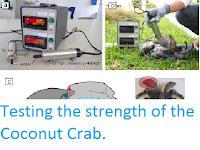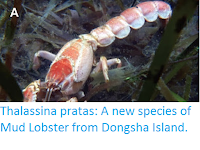Hermit Crabs, Paguroidea, are highly specialised Decapod Crustaceans that have largely soft exoskeletons and recycle the shells of other animals, usually Gastropod Molluscs, as protection for their bodies. This enables them to live high in the litoral zone (beach environments) where calcium for making shells is hard to get but Crab-eating predators are common, thereby exploiting an environment effectively closed to other Crabs. Hermit Crabs are found on beaches throughout the world's tropical and temperate regions, though they are far more abundant in the tropics, and some members of the group have colonised other environments.
In a paper published in the journal Raffles Bulletin of Zoology on 30 May 2017, Jibom Jung of the School of Biological Sciences at Seoul National University, Rafael Lemaitre of the Department of Invertebrate Zoology at the Smithsonian National Museum of Natural History, and Won Kim, also of the School of Biological Sciences at Seoul National University, describe a new species of Hermit Crab from deep-water environments in the Bohol Sea, which separates the Visayas Islands (Panay, Negros, Cebu, Bohol, Leyte and Samar) from Mindanao in the Philippines.
The new species is placed in the genus Tomopaguropsis, which has previously been recorded from the southwest coast of India, the Caribbean Sea and Indonesia, and given the specific name rahayuae, in honour of Dwi Listyo Rahayu of the Research Centre for Oceanography of the Indonesian Institute of Sciences, for her work on Hermit Crabs, and for identifying the specimens used in this study, which were collected in 2005 by the Philippine Research Vessel MV DA-BFAR, and had remained unidentified in the collection of the Lee Kong Chian Natural History Museum at the National University of Singapore, as a new species.
Tomopaguropsis rahayuae is described from two specimens, both female, collected at depths of 269-280 m and 669-712 m respectively. These are 4.3 and 4.8 mm in length, and were found occupying the shells of Scaphopod Tusk Shells rather than Gastropods. These specimens, unlike other known members of the genus, have straight, rather than coiled bodies; however it is unclear if this is a diagnostic feature of the species, as a number of other Hermit Crabs are known to develop straight bodies when dwelling in Scaphopod shells, but still develop coiled bodies when dwelling in Gastropod shells.
Tomopaguropsis rahayuae, female, 4.3 mm, (A) shield, cephalic appendages, and part of
posterior carapace, dorsal view; (B) right cheliped, dorsal view; (C) left cheliped, dorsal view; (D) coxa and ischium of third maxilliped, and sternite IX, ventral view. B, C: Setae partially omitted. Scale bars: (A)–(C) 2 mm; (D) 0.5 mm. Jung et al. (2017).
posterior carapace, dorsal view; (B) right cheliped, dorsal view; (C) left cheliped, dorsal view; (D) coxa and ischium of third maxilliped, and sternite IX, ventral view. B, C: Setae partially omitted. Scale bars: (A)–(C) 2 mm; (D) 0.5 mm. Jung et al. (2017).
See also...
Follow Sciency Thoughts on Facebook.







